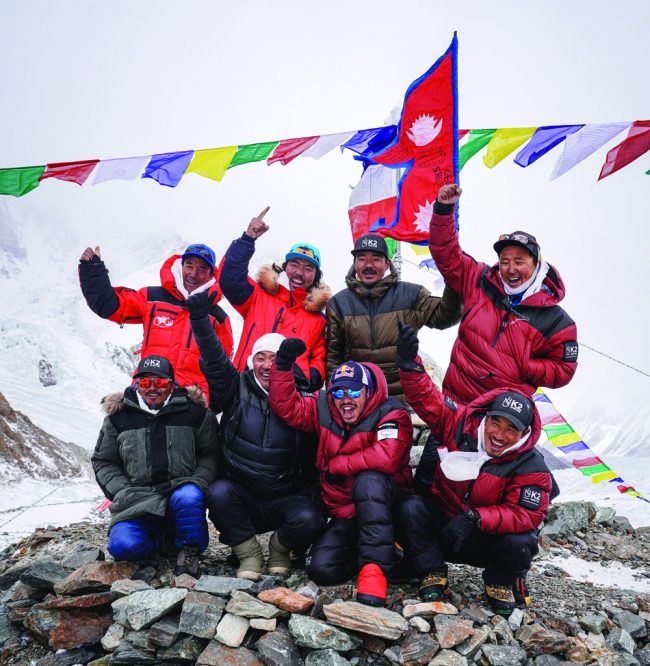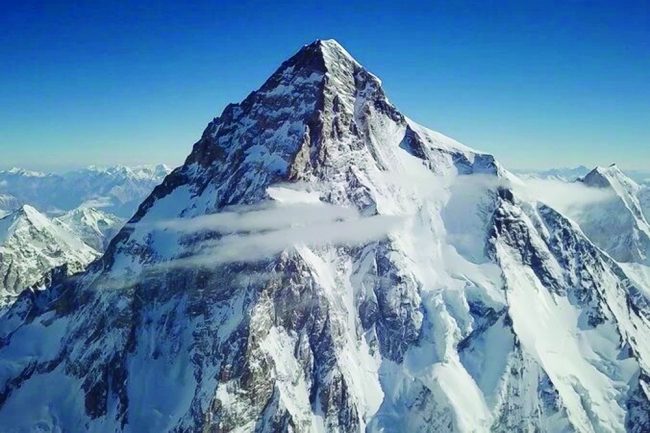How Sherpas Reached K2 Summit in Winter for the First Time

Left: Dawa Tenji Sherpa, Mingma G, Dawa Temba Sherpa and Pem Chiri Sherpa. From bottom left: Mingma David Sherpa, Mingma Tenzi Sherpa, Nirmal Purja and Geljen Sherpa. (Not pictured: Kilu Pemba Sherpa and Sona Sherpa.
Kathmandu: At around noon on Saturday, the climbers inched into the infamous passage called the Bottleneck on K2, the second-tallest mountain in the world and one never before conquered in winter.
The sky was clear, the wind manageable and the summit just beyond this final and most perilous stretch.
If they could navigate the Bottleneck, the team of 10 Nepalese climbers, led by Nirmal Purja, 37, who is known as Nimsdai, would likely become the first to climb K2 in winter. But Purja knew it was best to ignore the history at his frostbitten fingertips, and focus on taking one step at a time.
A gleaming, glacial 28,251-foot monolith that straddles the border of China and Pakistan, K2 has retained the same perfunctory name annotated on an original 19th-century British surveyor’s map of the Karakoram range.
Since the 1950s, it has also been known as Savage Mountain for its deadly reputation. For every four climbers who reach its summit, one dies. By comparison, the death rate on Mount Everest has been around 1
 That thin margin for error was underlined on Saturday, when Sergi Mingote, a Spanish climber who had reached 10 of the world’s highest peaks without supplemental oxygen, fell to his death much lower on the mountain.
That thin margin for error was underlined on Saturday, when Sergi Mingote, a Spanish climber who had reached 10 of the world’s highest peaks without supplemental oxygen, fell to his death much lower on the mountain.
The tragedy occurred hours after the Nepalese funneled through the Bottleneck, an hourglass-shaped gully that runs beneath an unstable overhanging ice cliff, called a serac. The serac routinely sheds enormous blocks of ice. Even before they reached the Bottleneck, the climbers saw foreboding debris fields.
“Some pieces were the size of a house,” Purja said from base camp on Monday. “You get intimidated by that. But if it’s your day, it’s your day. I was just praying to the mountain. This time we needed passage, and the mountain allowed us permission.”
The trick was not to rush. Elevations above 26,000 feet are in the so-called death zone. And though any climber caught in the Bottleneck at the wrong time faces certain injury and likely death, getting spooked and moving too fast at that altitude could bring a slow death.
High-altitude pulmonary edema is the biggest threat. That’s when pulmonary blood vessels constrict, ratcheting up pressure in the lungs, causing fluid to leak into the air sacs. The only cure is to head down the mountain for more oxygen. When pulmonary edema is ignored, breathing becomes more difficult, and soon blood and fluid might leak into the brain, an often fatal syndrome known as cerebral edema.
Linked to a rope they’d fixed to the ice, Purja and the other climbers stepped around such unspoken truths like so many shattered ice houses. It certainly helped that all but Purja were breathing supplemental oxygen, but even climbers on oxygen have been known to become lethargic and lose mobility.
“And if your oxygen canister runs out,” said the climber and cinematographer Renan Ozturk, “you could just shut your eyes for a second, and never wake up.”
Central Asia is home to all 14 of the world’s 8,000-meter (26,246 feet) peaks. All but K2 had been climbed in both summer and winter. Thanks to its remote location, avalanche prone slopes, temperatures hovering around minus-60 degrees Fahrenheit, and hurricane-force winds, a winter ascent of the mountain was the last great challenge remaining for serious mountaineers. Many considered it impossible.
Even a successful spring or summer climb of K2 is rare. Fewer than 400 climbers have been to its apex. More people have been to outer space than have stood on its summit.
There had been six prior winter attempts over the years, the most recent a failed Polish expedition in 2018. But the Nepalese climbers making their way last weekend were born in the Himalayas and nine of them were Sherpa.
For generations, since Tenzing Norgay and Edmund Hillary became the first to climb Mount Everest, in 1953, Sherpa people have worked as guides, facilitators and collaborators on countless historic mountaineering feats. Yet they have often been rendered invisible by the global lens and have seldom received their due. Hillary was knighted by Queen Elizabeth after the Everest triumph. Norgay was not. And none have been credited with first ascents in Nepal. — New York Times
